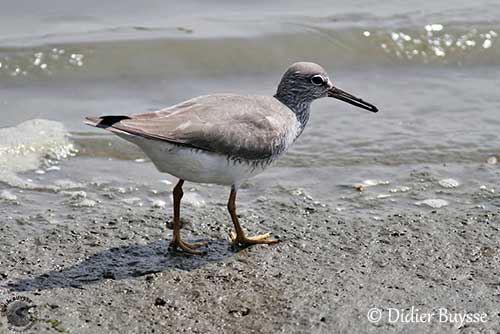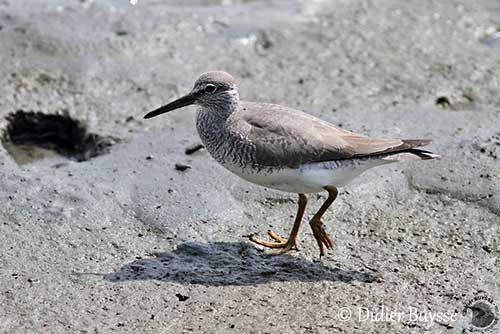
Fr: Chevalier de Sibérie
Ang: Grey-tailed Tattler
All: Grauschwanz-Wasserläufer
Esp: Playero Siberiano
Ita: Piro piro siberiano
Nd: Siberische Grijze Ruiter
Sd: sibirisk gråsnäppa
Photographers:
Didier Buysse
Vision d’Oiseaux
Ian McHenry
My New Zealand Birds
Alan & Ann Tate
AA Bird Photography
Text by Nicole Bouglouan
Sources:
HANDBOOK OF THE BIRDS OF THE WORLD Vol 3 by Josep del Hoyo-Andrew Elliott-Jordi Sargatal - Lynx Edicions - ISBN: 8487334202
SHOREBIRDS by Peter Hayman, John Marchant and Tony Prater – Christopher Helm – 1986 – ISBN: 0747014035
GUIDE DES LIMICOLES de D. Taylor - Delachaux et Niestlé - ISBN : 2603014080
A Field Guide to the Birds of South-East Asia by Craig Robson. New Holland Publishers. ISBN: 9781780090498
A photographic guide to Birds of the Philippines by Tim Fisher and Nigel Hicks. New Holland Publishers. ISBN: 9781847738301
Avibase (Denis Lepage)
Birdlife International
Birds in backyards (Birds Australia and Australian Museum)
Conservation India - Rare Bird Alert — Grey-tailed Tattler in Pulicat Lake
Unusual behaviour between Grey-tailed Tattlers
Wikipedia, the free encyclopaedia
Grey-tailed Tattler
Tringa brevipes
Charadriiformes Order – Scolopacidae Family
INTRODUCTION:
The Grey-tailed Tattler is an elegant wader that breeds in Siberia and migrates southwards to spend the winter in SE Asia, including some Pacific islands.
It is usually seen on reefs, rocky shores and intertidal mudflats, often in sheltered coastal areas. It feeds on insects, small crabs and other crustaceans and molluscs, sometimes fish too. It breeds in NE Siberia and nests on the ground on stony riverbed.
The Grey-tailed Tattler is affected by degradation and loss of the habitat, disturbance and hunting pressure on the wintering areas and at stopover sites.
The species is currently listed as Near Threatened.

DESCRIPTION OF THE BIRD:
Biometrics:
Length: 23-27 cm
Wingspan: 60-65 cm
Weight: 80-162 g
The Grey-tailed Tattler is very similar to the Wandering Tattler and both species are not easy to separate.
The adult in breeding plumage has uniformly slate-grey upperparts including crown, hindneck, wings and tail, with faint brownish tinge. The uppertail-coverts show some faint white bars, whereas on the upperwing, outer greater coverts and inner primary coverts have narrow white tips.
On the underparts, breast and upper flanks are white with narrow grey chevrons. Belly, lower flanks, vent and a large part of the undertail are white. On the underwing, axillaries and coverts are dark grey with narrow white tips. The flight-feathers are slightly paler and browner than the underwing-coverts.
On the head, the white supercilium reaches the forehead. Lores and post-ocular stripe are dark grey and the narrow eyering is white. Ear-coverts, cheeks and neck (front and sides) are white with grey streaks. There is a small, white chin-patch.
The straight bill is blackish, with yellowish base of lower mandible. The eyes are dark brown. The short, thick legs and the feet are bright yellow.
Male and female are similar, but the female is larger than male.
The non-breeding adult has greyish-white flanks and the underparts are uniformly white. Neck sides and breast are tinged slate-grey.
The juvenile resembles non-breeding adult, but breast and flanks are barred with grey. Wing-coverts, tertials and scapulars are spotted and tipped white. On the tail, the central rectrices show whitish barring towards the tip.
RANGE:
The Grey-tailed Tattler breeds through NE Siberia and probably in N Kuril Islands too. It winters from Taiwan, Malay Peninsula and Philippines, S through Indonesia, New Guinea and Solomon Islands to Australia. Small numbers may reach New Zealand, also Fiji and Tuvalu.
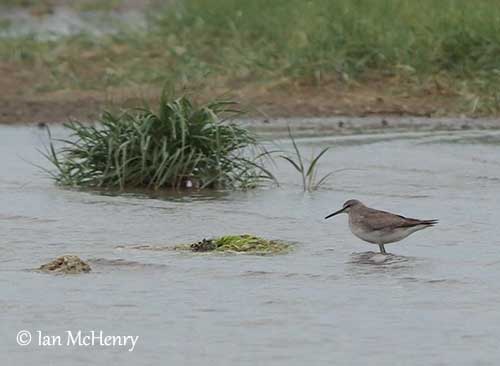
Observation of this
bird in New Zealand
HABITAT:
The Grey-tailed Tattler usually frequents sheltered coasts with reefs, rock platforms and intertidal mudflats. It also perches on rocks, coral or stony reefs and islets exposed at high tide. It is also seen on rocky shores or with shingle or gravel, and in mudflats in estuaries, bays and coastal lagoons bordered with mangroves.
CALLS AND SONGS: SOUNDS BY XENO-CANTO
The Grey-tailed Tattler gives a plaintive “tu-weet” sometimes repeated in flight. The alarm call is a more hurried “tu-wiwi” and “twiwiwi”. We can also hear a strident “klee”.
BEHAVIOUR IN THE WILD:
The Grey-tailed Tattler feeds on marine worms, molluscs, crustaceans and insects, and occasionally fish. Small crabs are usually much appreciated. Insects are eaten during the breeding season.
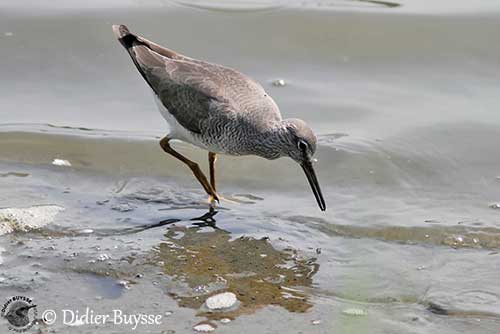
It feeds alone or in small flocks, sometimes up to 50 individuals. They forage among vegetation at water edge, but also on floating weeds and algae.
It darts about while bobbing and teetering between bouts of running. The prey are detected by sight and by probing with the bill. The small crabs are dropped and thrown in order to remove their legs before to eat them.
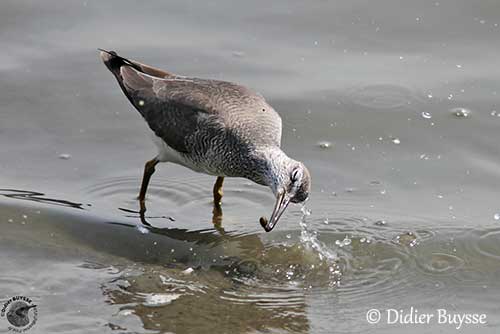
During the breeding season, the male performs a high circling display flight while singing. This species nests on the ground among stones. They are monogamous and both adults share the nesting duties.
When alarmed, it stands upright and extends the neck. If disturbed, it usually crouches down, but when flushed, it towers high.
The Grey-tailed Tattler is migratory, with mainly coastal routes, although they can be seen sometimes on inland wetlands and rivers.
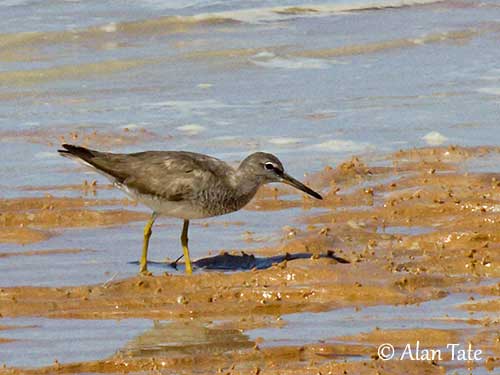
On passage, they may occur on Bering Sea islands, Aleutian Islands, Kuril Islands, Korea, Japan, NE China, Hong Kong and Philippines. There are some movements across Mongolia and C China, and across SW Pacific.
Migrations occur in July/mid-October and March/late May.
The species is vagrant to NW Europe, Indian Ocean Islands, India, Bangladesh, and in some USA states including Washington, California and Massachusetts.
The flight is fast and effortless, with rapid wingbeats interspersed with glides on arched wings. The wingbeats may sometimes appear rather weak and fluttering.
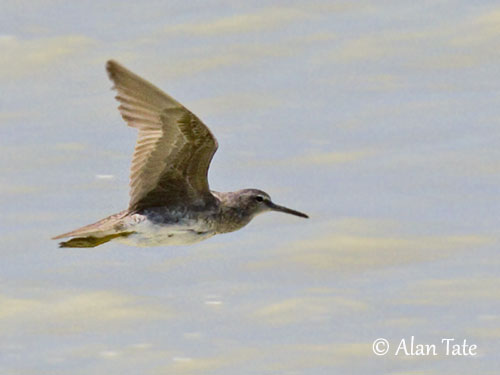
REPRODUCTION OF THIS SPECIES:
The breeding season takes place between May and late August. They usually arrive when their breeding sites are still covered with snow and ice.
The Grey-tailed Tattler nests on the ground in a shallow depression on stony riverbed. However, it may occasionally use old tree-nests abandoned by other bird species. The cup is lined with grass.
The female usually lays 4 eggs. Both parents share the nesting duties. The chicks are fed on insects.
No further information.
PROTECTION / THREATS / STATUS:
The Grey-tailed Tattler is affected by degradation and loss of its habitat, especially the wetlands, caused by pollution and expansion of both urban and industrial developments.
At stopovers and on the wintering grounds, the birds are threatened by hunting pressure and disturbance.
The global population was estimated to number 44,000 individuals in 2014, including roughly 29,500 mature individuals.
The Grey-tailed Tattler is currently listed as Near Threatened.
